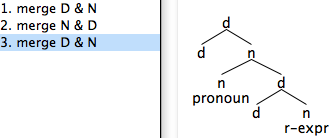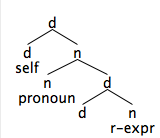 |
 |
A doubling constituent (DC) combines a pronoun or anaphor with its antecedent. Covert d and self head the pronominal and reflexive DCs, respectively. A pronoun selects for its antecedent (and crucially not the other way around). |
An antecedent must escape the DC to be properly (theta and Case) licensed. Self (not null d) is a phase head.
Note: The latter assumption accounts for the differences in distribution between pronominals and anaphors.
(I) c (complementizer), (II) v ("little v") when limited to v*, and (III) d (determiner) when it is self or possessive 's.
Note: v* and 's both provide for a subject theta position, self doesn't.
Note: active lexical items contain unvalued feature(s).
Note: regular move is limited to merge to heads that have an EPP (or edge) feature. These are t (tense) and c (when Q).